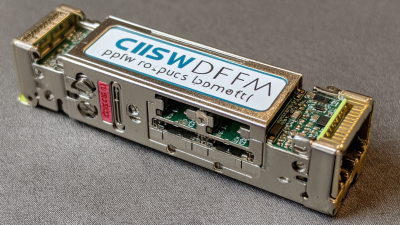Leave Your Message
In today's rapidly evolving digital landscape, the demand for high-capacity, efficient, and reliable networking solutions is more critical than ever. According to the 2023 Global Network Report, data traffic is projected to increase by 50% annually over the next five years, necessitating innovative technologies that can keep pace. One such technology is the Cisco DWDM SFP+, which offers unprecedented bandwidth capabilities and scalability for next-gen global networks.
 With its ability to facilitate the transmission of large volumes of data over long distances with minimal latency, Cisco DWDM SFP+ is not just a component but a strategic asset for organizations looking to enhance their infrastructure.
As businesses seek to meet the burgeoning demands for speed and connectivity, understanding the proven benefits of implementing Cisco DWDM SFP+ will be pivotal for future success in the competitive networking arena.
With its ability to facilitate the transmission of large volumes of data over long distances with minimal latency, Cisco DWDM SFP+ is not just a component but a strategic asset for organizations looking to enhance their infrastructure.
As businesses seek to meet the burgeoning demands for speed and connectivity, understanding the proven benefits of implementing Cisco DWDM SFP+ will be pivotal for future success in the competitive networking arena.
The rise of Dense Wavelength Division Multiplexing (DWDM) technology is transforming global networking at an unprecedented pace. With the optical communication market projected to grow from $15.53 billion in 2024 to $29.52 billion by 2032, companies are increasingly recognizing the importance of adopting DWDM solutions to enhance their connectivity capabilities. This technology allows multiple data streams to be transmitted simultaneously over a single optical fiber, significantly boosting bandwidth and network efficiency.
As the demand for high-speed communication rises, investing in advanced DWDM technologies is essential. For organizations exploring this upgrade, here are a few tips: First, assess your current network infrastructure to identify compatibility with DWDM solutions. Next, focus on scalability; choose systems that can easily expand to accommodate future growth. Finally, stay informed about market trends and innovations, as the optical communication landscape is rapidly evolving. By strategically leveraging DWDM technology, businesses can ensure they remain competitive in a data-driven world.
Embracing trends such as the projected 11.5% CAGR in coherent optical transceivers between 2024 and 2030 or the anticipated growth in wavelength services can further enhance network performance. The collaboration between major players in the industry continues to lead to groundbreaking achievements, reinforcing the need for robust, future-ready networks. Organizations must prioritize these advancements to unlock the full potential of their networking capabilities.
In recent years, SFP+ modules have become integral to the evolution of global networks, particularly with the shift towards higher transmission rates. The market for optical transceivers is projected to grow dramatically, with estimates predicting an increase from $15.27 billion in 2024 to $39.38 billion by 2031, showcasing a compound annual growth rate (CAGR) of 14.49%. This surge reflects the demand for robust performance in next-generation networking solutions and highlights the significance of technologies such as Cisco DWDM SFP+ in meeting these needs.

The advent of SFP+ modules, especially those that support Dense Wavelength Division Multiplexing (DWDM), positions them as crucial components for creating high-performance communication infrastructures. Recent advancements illustrate that while high-speed optical modules are becoming mainstream, there is still a crucial market for lower-speed options that provide distinct advantages in various applications. The need for low latency and high reliability has never been more paramount, particularly as initiatives like the national-level "Eastern Data, Western Computing" project unfold, aiming to establish extensive high-quality networking frameworks across regions.
The demand for high-speed data transmission is ever-increasing, driving the need for advanced networking solutions. Cisco's DWDM SFP+ modules exemplify this advancement, providing a proven technology that enhances performance while maintaining cost efficiency. According to a report by Cisco, by 2022, global IP traffic is expected to reach 4.8 zettabytes per year, with data center traffic alone predicted to grow by 27% annually. This surge underscores the necessity for scalable and reliable solutions like DWDM (Dense Wavelength Division Multiplexing), which enables multiple data channels to operate simultaneously over a single fiber optic cable.
One of the standout advantages of Cisco's DWDM SFP+ technology is its ability to dramatically increase bandwidth capacity. With the capability of transmitting up to 100 Gbps per wavelength, it allows networks to accommodate growing data demands without extensive infrastructure overhauls. Furthermore, a report from MarketsandMarkets projects that the DWDM market size will grow from $4.5 billion in 2020 to $6.8 billion by 2025, highlighting the industry's shift towards high-capacity transmission solutions. These modules not only enhance overall network efficiency but also ensure minimal latency, essential for applications like cloud computing and real-time data analytics.
| Benefit | Description | Impact on Network |
|---|---|---|
| High-Speed Transmission | Supports data rates up to 100G, enabling faster data transfer across networks. | Increases overall network performance and user experience. |
| Enhanced Scalability | Easily integrates into existing infrastructure, allowing for easy upgrades. | Facilitates growth and expansion of network capabilities. |
| Cost Efficiency | Reduces overall operational costs by optimizing bandwidth usage. | Increases ROI on network investments. |
| Reduced Latency | Minimizes delays in data transmission for real-time applications. | Improves performance for critical applications like video streaming and online gaming. |
| Increased Reliability | Robust design ensures high availability and less downtime. | Enhances service continuity and user trust in network availability. |
As global networks increasingly demand robust and adaptable solutions, Dense Wavelength Division Multiplexing (DWDM) technology emerges as a transformative force. The scalability and flexibility offered by Cisco DWDM SFP+ modules are pivotal for optimizing network efficiency. According to a report from MarketsandMarkets, the DWDM market is projected to grow from $6.35 billion in 2020 to $11.95 billion by 2025, reflecting a compound annual growth rate (CAGR) of 13.1%. This surge underscores the necessity for high-capacity transport solutions to support the rapid growth of data traffic, driven by cloud computing, streaming services, and IoT applications.
Cisco’s DWDM SFP+ modules enable service providers to expand their networks seamlessly. With the ability to increase bandwidth without extensive infrastructure upgrades, organizations can respond effectively to fluctuating data requirements. A study by Gartner suggests that adopting DWDM technology can lead to a 50% reduction in the cost per bit transmitted, allowing businesses to enhance their operational efficiency significantly. Furthermore, Cisco's approach facilitates easier integration with existing systems, streamlining network management and reducing downtime, which are crucial aspects for enterprises aiming to maintain a competitive edge in today's fast-paced digital landscape.
This chart illustrates the benefits of utilizing DWDM technology in global networks, focusing on scalability and flexibility, which enhance overall network efficiency.
 As global networks continue to evolve, the demand for robust, scalable solutions grows increasingly critical. Cisco DWDM SFP+ modules represent a strategic long-term investment, aligning perfectly with future-proofing your infrastructure. According to a recent report from Research and Markets, the global Dense Wavelength Division Multiplexing (DWDM) market is projected to exceed $21 billion by 2025. This growth underscores the significance of adopting modular solutions that not only enhance bandwidth efficiency but also extend the lifecycle of network investments.
As global networks continue to evolve, the demand for robust, scalable solutions grows increasingly critical. Cisco DWDM SFP+ modules represent a strategic long-term investment, aligning perfectly with future-proofing your infrastructure. According to a recent report from Research and Markets, the global Dense Wavelength Division Multiplexing (DWDM) market is projected to exceed $21 billion by 2025. This growth underscores the significance of adopting modular solutions that not only enhance bandwidth efficiency but also extend the lifecycle of network investments.
Utilizing DWDM SFP+ technology allows organizations to maximize their existing optical fiber infrastructure, delivering high-capacity data transfer while minimizing operational costs. A study by LightCounting in 2023 indicated that networks equipped with DWDM technology can achieve data rates exceeding 100Gbps over hundreds of kilometers, fostering seamless connectivity in an increasingly data-driven landscape.
Tip 1: Invest in training for your technical teams to ensure they are well-versed in DWDM technology, maximizing the effectiveness of your investment.
Tip 2: Regularly assess network capacity and anticipate future growth to make informed decisions about when to upgrade or expand your DWDM setup.
Tip 3: Consider working with experts to design a bespoke DWDM solution tailored to your specific operational needs, ensuring you fully leverage this technology's potential.






